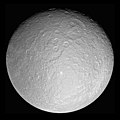Datoteka:PIA07763 Rhea full globe5.jpg

Veličina ovog prikaza: 600 × 600 piksela. Ostale razlučivosti: 240 × 240 piksela | 480 × 480 piksela | 768 × 768 piksela | 1.024 × 1.024 piksela | 2.048 × 2.048 piksela | 4.920 × 4.920 piksela.
Vidi sliku u punoj veličini (4.920 × 4.920 piksela, veličina datoteke: 2,67 MB, MIME tip: image/jpeg)
Povijest datoteke
Kliknite na datum/vrijeme kako biste vidjeli datoteku kakva je tada bila.
| Datum/Vrijeme | Minijatura | Dimenzije | Suradnik | Komentar | |
|---|---|---|---|---|---|
| sadašnja | 09:15, 27. kolovoza 2018. |  | 4.920 × 4.920 (2,67 MB) | PlanetUser | Reverted to version as of 08:13, 13 March 2015 (UTC) |
| 12:09, 15. kolovoza 2018. |  | 4.920 × 4.920 (2,66 MB) | The NMI User | Reverted to version as of 23:49, 14 August 2018 (UTC) | |
| 01:59, 15. kolovoza 2018. |  | 4.920 × 4.920 (2,64 MB) | The NMI User | rv, fixed | |
| 01:49, 15. kolovoza 2018. |  | 4.920 × 4.920 (2,66 MB) | The NMI User | Try making black | |
| 01:44, 15. kolovoza 2018. |  | 4.920 × 4.920 (2,65 MB) | The NMI User | Fixed | |
| 10:09, 13. kolovoza 2018. |  | 4.920 × 4.920 (3,67 MB) | The NMI User | Removing black borders | |
| 10:01, 13. kolovoza 2018. |  | 4.920 × 4.920 (2,67 MB) | The NMI User | Reverted to version as of 08:13, 13 March 2015 (UTC) | |
| 09:56, 13. kolovoza 2018. |  | 4.920 × 4.920 (5,67 MB) | The NMI User | Black background | |
| 10:13, 13. ožujka 2015. |  | 4.920 × 4.920 (2,67 MB) | MoreTomorrow | making square (to match other planet/moon images) | |
| 08:43, 30. listopada 2008. |  | 4.920 × 4.820 (2,68 MB) | WolfmanSF | This is the same full-resolution NASA image, with black panels added to the margins and some Photoshop processing to enhance contrast. |
Uporaba datoteke
Na ovu sliku vode poveznice sa sljedećih stranica:
Globalna uporaba datoteke
Sljedeći wikiji rabe ovu datoteku:
- Uporaba na af.wikipedia.org
- Uporaba na ar.wikipedia.org
- قالب:المجموعة الشمسية
- قائمة أجرام المجموعة الشمسية مرتبة حسب الحجم
- قائمة أجرام النظام الشمسي المستديرة بالجاذبية
- قائمة الأقمار الطبيعية
- خط زمني لاكتشاف كواكب المجموعة الشمسية وأقمارها
- اكتشاف واستكشاف النظام الشمسي
- قائمة أنواع الكواكب
- بوابة:زحل/مقالة مختارة وصورة لأحد أقمار زحل
- قائمة أكبر الفوهات في المجموعة الشمسية
- 1981 ميداس
- Uporaba na ary.wikipedia.org
- Uporaba na arz.wikipedia.org
- Uporaba na ast.wikipedia.org
- Uporaba na as.wikipedia.org
- Uporaba na azb.wikipedia.org
- Uporaba na be.wikipedia.org
- Uporaba na bh.wikipedia.org
- Uporaba na ca.wikipedia.org
- Uporaba na ckb.wikipedia.org
- Uporaba na de.wikipedia.org
- Uporaba na el.wikipedia.org
- Uporaba na en.wikipedia.org
- Pioneer 11
- Rhea (moon)
- Cassini–Huygens
- Timeline of discovery of Solar System planets and their moons
- List of geological features on Rhea
- Naming of moons
- List of natural satellites
- List of gravitationally rounded objects of the Solar System
- Wikipedia:WikiProject Astronomy/Recognized content
- Portal:Solar System/Selected picture
- User:Dabomb87/Sandbox
- Tirawa (crater)
- Rings of Rhea
Pogledajte globalnu uporabu ove datoteke.



